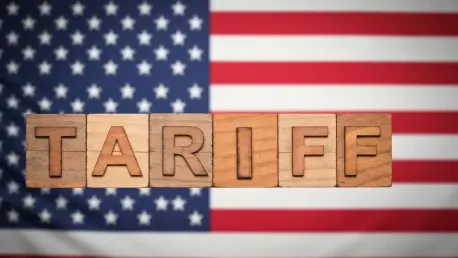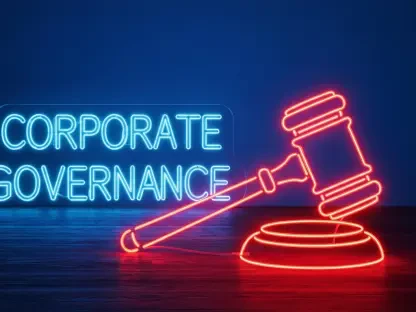In the current economic landscape, American businesses are grappling with an unprecedented challenge as tariff policies under President Trump’s administration have unleashed a wave of compliance costs that threaten to reshape entire industries. A staggering 89% of executives, according to a recent KPMG survey, anticipate major operational disruptions over the next few years due to these expansive trade measures. This alarming statistic underscores a critical turning point for sectors like manufacturing and retail, where the burden of navigating complex regulations and avoiding hefty penalties has become a daily struggle. The ripple effects are felt not just in corporate boardrooms but also in the wallets of everyday consumers facing rising prices. This report delves into the intricacies of the tariff landscape, exploring the economic impacts, regulatory challenges, and future implications for US firms navigating this turbulent environment.
Understanding the Tariff Landscape
The trade policies implemented under President Trump’s administration have introduced sweeping tariff measures that target a wide array of imported goods, aiming to bolster domestic industries through protectionist strategies. These policies encompass tariffs on critical inputs for manufacturing as well as consumer goods, fundamentally altering the cost structures for businesses reliant on global supply chains. With a focus on reducing trade deficits and encouraging American production, the administration has prioritized high tariffs as a tool to reshape economic priorities, impacting everything from steel imports to everyday household items.
The significance of these measures extends across the US economy, with industries such as manufacturing and retail bearing the brunt of increased costs and operational complexities. Manufacturers face higher expenses for raw materials, while retailers struggle to absorb or pass on the added costs without alienating price-sensitive customers. The broader economic implications include potential inflationary pressures and shifts in market dynamics, as companies reassess their sourcing strategies under intense financial strain.
Key market players, including importers, domestic manufacturers, and consumer goods companies, are directly affected by this evolving landscape. Importers are hit with the immediate burden of tariff payments, while domestic manufacturers grapple with supply chain adjustments and higher production costs. Technological tools, such as advanced supply chain tracking software, have become indispensable for many firms, aiding in compliance by verifying product origins and mitigating the risk of penalties, though they add another layer of expense to already stretched budgets.
Economic Impacts and Market Trends
Rising Compliance Costs and Operational Disruptions
The surge in compliance costs for US firms is driven by the intricate web of trade regulations that accompany the current tariff regime. Companies face not only the direct cost of tariffs but also the administrative burden of ensuring adherence to rules, with severe penalties for non-compliance, such as 40% fines on transshipments. This regulatory complexity has forced businesses to allocate significant resources to hiring trade experts and expanding compliance teams, diverting funds from growth initiatives.
To counter these challenges, many firms are adopting technologies like supply chain tracking software to enhance visibility and ensure regulatory adherence. Additionally, trends such as nearshoring or reshoring—relocating operations closer to or within the US—have gained traction as strategies to mitigate tariff risks. However, these adaptations come with substantial upfront investments, further straining operational budgets and challenging the financial resilience of smaller enterprises.
Consumer behavior is also shifting in response to the inevitable price increases resulting from passed-on compliance costs. Social media platforms are abuzz with frustration, as shoppers lament the rising cost of essentials and question the promised benefits of protectionist policies. This growing discontent highlights a disconnect between policy objectives and economic realities, as households feel the pinch of reduced affordability in their daily purchases.
Market Data and Economic Forecasts
Data from reputable sources paints a stark picture of the economic toll these tariffs are taking on businesses and consumers alike. A KPMG survey indicates that 86% of affected companies plan to offset compliance expenses by raising prices, while the Tax Foundation estimates an average annual cost increase of $1,200 per US household due to these trade measures. Such figures reveal the widespread financial impact, extending beyond corporate balance sheets to the everyday lives of Americans.
Economic forecasts suggest further challenges, with projections indicating a 2.3% overall price increase for goods and potential surges of 20-30% for specific imported products over the next few years. These numbers, coupled with warnings of inflation spikes from economists, signal a looming threat to economic stability. The risk of retaliation from trade partners like China and the European Union adds another layer of uncertainty, potentially exacerbating disruptions in global markets.
Looking ahead, the long-term operational challenges for US firms remain a pressing concern. Analysts predict that without significant policy adjustments, businesses will continue to face supply chain bottlenecks and reduced competitiveness. The cumulative effect of these pressures could reshape industry landscapes, forcing companies to prioritize survival over innovation in an increasingly volatile economic environment.
Challenges Facing US Businesses
US firms are confronting a myriad of obstacles as they navigate the fallout from expansive tariff policies, with supply chain disruptions emerging as a primary concern. The risk of penalties for transshipments has intensified scrutiny over sourcing practices, compelling companies to invest heavily in due diligence to verify the origins of their goods. This heightened oversight, while necessary, disrupts established supply networks and adds significant delays to production timelines.
Market-driven challenges compound these issues, as businesses grapple with the decision to absorb costs or pass them on to consumers. Raising prices risks alienating customers and losing market share, while absorbing costs erodes profit margins and threatens financial viability. Additionally, shifting to domestic sourcing often entails higher expenses due to elevated labor and material costs in the US, further undermining competitiveness against international rivals.
Potential solutions, such as diversifying suppliers across multiple regions or investing in compliance technologies, offer some relief but come with their own financial burdens. Smaller firms, in particular, struggle to allocate the necessary capital for such adaptations, highlighting a disparity in how different-sized businesses can respond to tariff pressures. The strain of these adjustments underscores the urgent need for strategic planning to balance compliance with operational sustainability.
Regulatory Environment and Compliance Burdens
The regulatory landscape surrounding tariffs is characterized by stringent measures designed to enforce compliance, including harsh penalties like 40% fines for transshipments. These rules place an immense administrative burden on companies, requiring meticulous documentation and verification of product origins to avoid costly violations. The complexity of these requirements often overwhelms existing systems, necessitating significant resource allocation to meet regulatory standards.
Recent policy adjustments, such as tariff exemptions on commodities like coffee and bananas, have been introduced to ease consumer price pressures. However, these measures have a limited impact on core manufacturing sectors, where tariffs on essential inputs remain unchanged. As a result, many businesses continue to face the same compliance challenges, with little relief from the overarching regulatory framework that governs trade.
The effect of these compliance requirements on industry practices is profound, with many firms redirecting resources from innovation and development to regulatory adherence. This shift in focus hampers long-term growth prospects, as companies prioritize short-term survival over strategic advancements. The persistent regulatory burden thus poses a systemic challenge, stifling the competitive edge of US businesses in a global marketplace.
Future Outlook for Trade and Tariffs
Looking toward the coming years, the trajectory of US trade policy suggests potential further tariff hikes by 2026, which could deepen the economic challenges for businesses and consumers. Such escalations would likely intensify compliance costs and price pressures, pushing firms to rethink their operational models under even tighter constraints. The uncertainty surrounding these developments keeps industries on edge, as they brace for additional disruptions.
Emerging strategies to counter these challenges include comprehensive supply chain restructuring and increased investments in technology to enhance transparency and efficiency. However, global trade tensions remain a significant market disruptor, with the possibility of retaliatory measures from key trade partners threatening to destabilize international relationships. These external factors add complexity to an already fraught economic landscape for American firms.
Innovation and evolving consumer preferences will play crucial roles in shaping the industry’s path forward, alongside broader economic conditions. Companies that can adapt through technological advancements or by aligning with shifting market demands may find opportunities amid the challenges. Nevertheless, the interplay of policy decisions and global dynamics will ultimately determine how effectively businesses can navigate this uncertain future.
Conclusion and Path Forward
Reflecting on the extensive analysis, it is clear that the tariff-driven economic strain has placed immense pressure on US firms, with compliance costs, price surges, and operational disruptions dominating the landscape. The challenges have permeated every level of the supply chain, from manufacturers to consumers, revealing a stark clash between protectionist intentions and practical economic outcomes. The data and trends paint a sobering picture of an industry at a crossroads, grappling with both immediate burdens and long-term uncertainties.
Moving forward, businesses should prioritize leveraging technology to streamline compliance processes, reducing the administrative load through automated tracking and verification systems. Advocating for broader tariff relief and engaging in industry collaboration could also pave the way for more sustainable trade policies. For policymakers, considering targeted exemptions that address core industrial needs rather than peripheral commodities might offer a balanced approach. Ultimately, fostering dialogue between government and industry stakeholders could unlock innovative solutions, ensuring that protectionism aligns more closely with economic stability in the years ahead.









